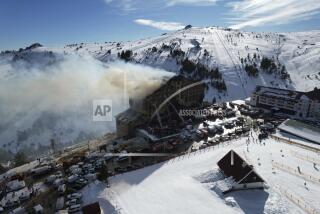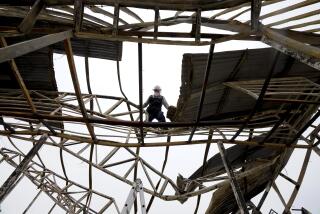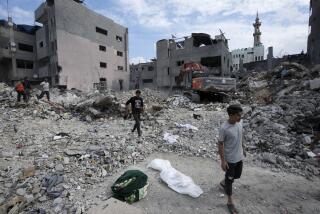Listening for Sounds of Life : Crews Dig Frantically, Families Wait in Fear
- Share via
MEXICO CITY — Searchlights probed the cracks in a mountain of twisted metal girders, torn curtains and shattered cement that was the Hotel El Romano. Suddenly a voice cried out from within. “Bring the stretchers!”
Shoving mattresses and broken furniture aside, the rescue worker emerged pulling a moaning woman from the rubble. Moments later, the broken but still-breathing body of a man was also dragged out of the ruins.
By sunrise, the muffled cries that had issued from the smashed building had ceased. Twenty-four hours after the first of two devastating earthquakes hit this city, relatives and neighbors of the estimated 3,000 people who were buried under hundreds of collapsed apartment complexes, business offices, schools and hospitals were giving up hope.
Devastation and Despair
Rescue crews made up of everyone from Girl Scouts to paratroopers dug frantically at building wreckage, listening for sounds of life. One of the world’s largest cities was a scene of devastation and despair.
Dazed by lack of sleep and an excruciating sense of loss, Mario Jiminez paced outside the twisted remains of the five-story apartment building where his family of seven lived.
“I don’t know anything,” he said, squinting through bloodshot eyes. “All I know is that under that pile of dirt there is my family.”
Miguel Angel Escamilla was another of thousands here engulfed in grief. At 7:18 a.m. the previous day, he watched his sons, Fernando Javier, 28, and Marco Antonio, 24, drive into the basement garage of the Hotel El Romano when the ground began to shake.
Tears streaming down his face, Escamilla said he could only stand by and watch as the six-story building in the hard-hit downtown area crumbled.
“My sons are dead,” Escamilla said, embracing his wife. “I saw everything.”
Similar scenes were played out throughout the stricken area as ambulance sirens screamed day and night, armed soldiers blocked off the most heavily damaged areas and volunteers wielded sledgehammers, pickaxes and shovels.
Tunnel Through Rubble
Like spelunkers, doctors and nurses made tunnels through the mounds of rubble at the collapsed Juarez Hospital to give oxygen, water and tranquilizers to their patients and colleagues trapped inside.
As many as 1,500 doctors, nurses, medical students and patients were thought to have been in the 12-story public hospital when it was shaken to the ground along with hundreds of other buildings on Thursday.
“There’s still no word,” said Guadalupe Casares, who sat on the sidewalk crying over what might be the fate of her 21-year-old daughter, Maria Soledad, a nursing student who had been working on the eighth floor of the Hospital.
Exhausted rescue workers said they had managed to dig about 130 victims from the hospital, but decided they could do little more without cranes to move the crumbled concrete walls.
“Many people inside will die, but it’s the only possibility we have for getting some more out alive,” said Dr. Carlos Rojas, a surgeon at the hospital.
The cries of the injured echoed in the night.
Dr. Fernando Lopez examined the ruins of the eight-story Montreal Hotel in the southern end of the capital and shook his head.
“There are only cadavers left in there,” Lopez said.
In Colonia Roma, one of the neighborhoods hardest hit by the earthquake, Juventino Benito Hernandez and his wife stood sobbing in front of the rubble that was once their three-story stucco apartment building. Their three small children were trapped inside.
Hernandez said he and his wife had left for work before the quake struck Thursday. They had rushed back to find the building in ruins.
‘No Answer’
“I called for my children, but there was no answer,” he said.
Rescue workers said they heard the couple’s 2-year-old daughter crying, but they feared that the two sons, ages 3 and 8, were dead.
Hernandez’ wife clutched a dust-covered Bible. Rescue workers gently led the couple, tears streaming down their faces, to a nearby bus to rest while the digging continued.
Throughout the city, volunteer brigades toiled side by side with Red Cross workers, police, engineers, fire crews and the military. But oftentimes it wasn’t enough.
Cuantemoc Cortez pleaded with a military official overseeing a rescue effort at a leveled multistory government building for help at a nearby building where his two brothers lay buried under tons of concrete.
But the harried official said he could not spare the manpower. As Cortez walked away, he said, “My father and I will do it with our hands.”
Bitter at Delay
At other sites, relatives and friends growing impatient with the painstaking slow work of digging out victims complained bitterly.
“We have no specialists for this type of disaster,” said Fernando Flores, whose son was one of hundreds of students trapped inside the Conalep technical school downtown. Flores was among the crowd that rushed forward to seek information on relatives each time an official emerged from the wreckage. The news was rarely encouraging.
“There are 45 students trapped in one room and 65 in another--squeezed like sardines,” a rescue worker told one expectant crowd. “We’re doing the best we can.”
A few blocks from the National Palace--the government headquarters--an eight-story apartment and commercial building had fallen into a heap less than two stories high, with entire sections of roof still intact.
Bodies on Sidewalk
Thirteen bodies wrapped in curtains, blankets and bath towels were stretched on the sidewalk nearby.
As they dug through the debris, the rescuers and the hundreds of spectators turned in unison and yelled, “Quiet!” at any vehicle that pulled up, so they could hear any voices under the rubble.
Sometimes the search for the missing led to makeshift morgues set up by the authorities. Antonio Villegas had gone to a morgue in the Cuauhtemoc borough offices to look for his sister amid the twisted bodies that lay in pools of melting ice. Among those still to be identified by relatives was the body of a young woman still clutching an infant.
By Friday, some residents of Colonia Roma ventured back to retrieve personal belongings from the shells of their damaged homes.
“We forgot this one,” said Obaldo Lopez, handing the family’s caged pet parrot from a second-story broken window to his son on the street below.
Recalling the desperation of the day before when he ran through a maze of roadblocks to reach home and assure himself of his family’s safety, Lopez said, “We feel fortunate to have survived. At least we got out alive.”
More to Read
Sign up for Essential California
The most important California stories and recommendations in your inbox every morning.
You may occasionally receive promotional content from the Los Angeles Times.











